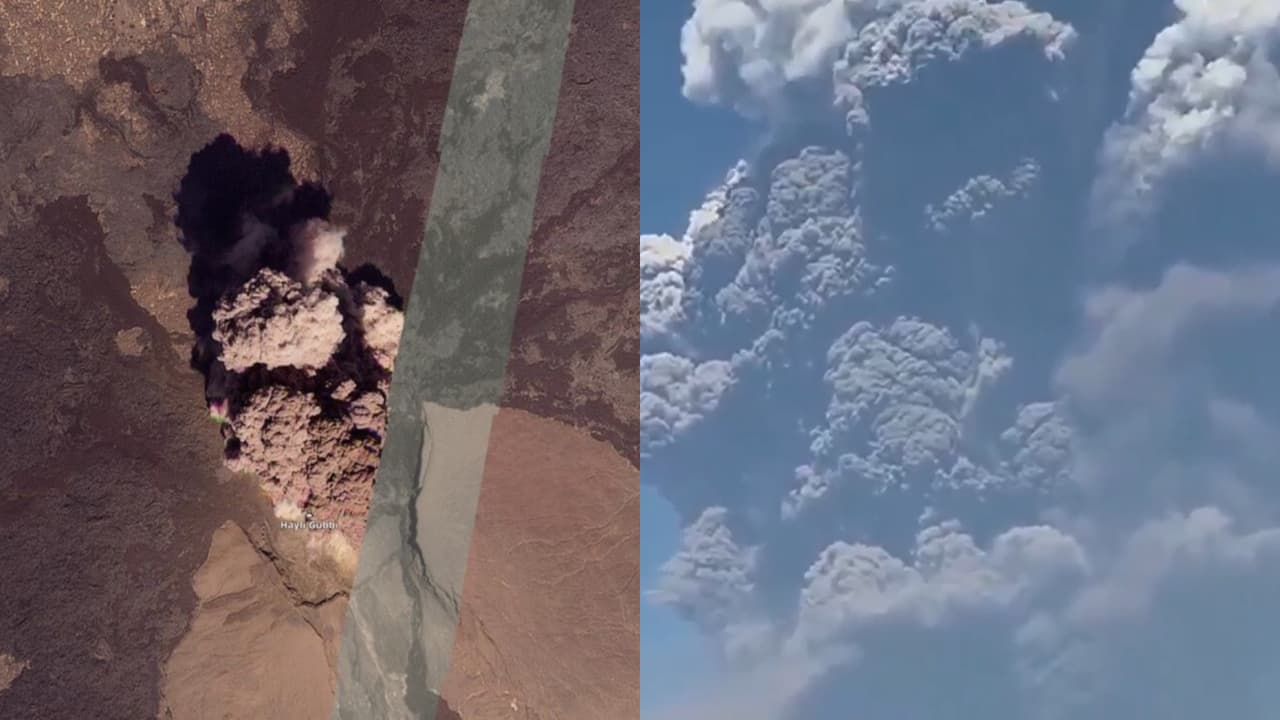A rare eruption of Ethiopia’s Hayli Gubbi volcano has pushed a large ash plume towards India, prompting alerts across western-northern states. Plume may affect skies over Gujarat, Maharashtra, Rajasthan, Delhi, Haryana, Punjab, West UP, Uttarakhand.
A rare volcanic eruption in Ethiopia has triggered a chain of alerts across India, as ash from the Hayli Gubbi volcano is drifting towards the Indian subcontinent. Aviation officials, weather watchers, and airlines are closely monitoring the movement of the ash cloud, which could impact skies over Gujarat, Maharashtra, Rajasthan, Delhi, Haryana, Punjab, Uttar Pradesh and Uttarakhand over the next several hours.
This volcano has erupted for the first time in more than 10,000 years, making the event unusual and significant.
Scroll to load tweet…
Volcano erupts for first time in recorded history
The Hayli Gubbi volcano, located in Ethiopia’s Afar Rift region, erupted on Sunday. It sent a huge ash plume rising up to 45,000 feet, according to early observations. Experts noted that this is the first eruption in recorded history, and its ash has travelled quickly across the Red Sea.
Reports confirmed that after crossing Ethiopia, the ash drifted across Oman and Yemen, and is now moving eastward towards India.
Scroll to load tweet…
Scroll to load tweet…
Weather trackers warn of drifting ash plume
IndiaMetSky Weather, which tracks real-time weather changes, issued a volcanic ash caution. According to their assessment, the ash plume is moving at 100-120 km/h in a north-east direction. They said the plume is currently at mid-upper levels of the atmosphere, but some impact on visibility and air quality is still possible. The expected movement of ash towards India is likely in Gujarat, Maharashtra and Rajasthan. From these regions, the ash is likely drift towards North-East Rajasthan, Delhi, Haryana, South-East Punjab and later in the night towards Western Uttar Pradesh, Uttarakhand and neighbouring Himalayan foothills.
Weather watchers say the sky may look hazy, almost like a dust storm, in some areas.
Flight movements impacted in India
The movement of volcanic ash is a serious concern for aviation because ash can damage aircraft engines. As a result, airlines have begun rerouting flights expected to cross affected zones.
On Monday, an IndiGo Kannur-Abu Dhabi flight (6E 1433) diverted to Ahmedabad to avoid the plume route. Another Indian carrier’s plane that landed in Abu Dhabi is undergoing full engine checks before returning. A senior official said:
“We know the areas impacted by ash plumes and are taking detours to avoid flying there.”
Scroll to load tweet…
Akasa Air also issued a statement on X, confirming the airline is monitoring developments and will follow all international safety rules. Flights passing near Jamnagar, where the plume was expected around 5.30 pm, are the first to experience changes.
Scroll to load tweet…
Impact on people and cities: What to expect
Experts say there is no need to panic. Most of the ash is at higher altitudes, but some light effect on air quality may occur. Indian states that may feel the impact:
Gujarat: Jamnagar, Rajkot, Ahmedabad
Maharashtra: North and central parts
Rajasthan: Jaisalmer, Jodhpur, Jaipur, Alwar
Delhi NCR: Delhi, Gurugram, Noida
Haryana: Many central districts
Punjab: South-eastern areas
Uttar Pradesh: West UP including Meerut, Muzaffarnagar
Uttarakhand: Plains and lower hills
What people are advised to do
Weather trackers suggest:
- Wearing a mask if skies turn dusty
- Expecting slightly poorer visibility in some areas
- Preparing for possible flight delays
They added that AQI changes may happen but are expected to be mild and temporary.
While India is not in danger from the eruption itself, the drifting ash cloud has created temporary disruptions in the skies. Authorities will continue to monitor the movement closely. For now, the focus is on keeping passengers safe, adjusting flight paths, and tracking how far the ash travels before conditions improve.
